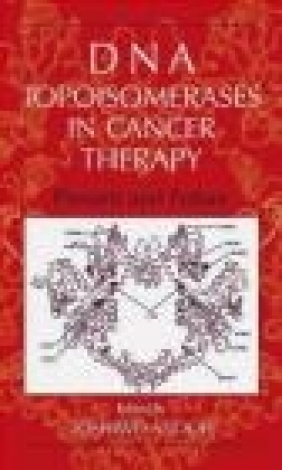DNA Topoisomerases in Cancer Therapy Present
Andoh
DNA Topoisomerases in Cancer Therapy Present
Andoh
- Producent: Kluwer Academic Publishers
- Rok produkcji: 2003
- ISBN: 9780306477447
- Ilość stron: 222
- Oprawa: Twarda
Niedostępna
Opis: DNA Topoisomerases in Cancer Therapy Present - Andoh
In the mid 80's, type I and II enzymes were found to be the intracellular targets of a number of efficacious anticancer drugs such as doxorubicin, mitoxantrone, etoposide and camptothecin as a result of a continued efforts of many investigators, especially Leroy Liu and his collaborators at Johns Hopkins University. Readers will find a series of chapters written by researchers actively engaged in the expanding field of topoisomerase and their inhibitors. The series of chapters cover review articles on pharmacology and the molecular mechanism of topoisomerase I- and II-targeting anticancer drugs in mammals and in the yeast Saccharomyces cerevisiae, which has proved to be a superb model organism for studies of anticancer drugs. This volume compiles up-to-date information on the topoisomerase-targeting compounds in clinical and preclinical development as a useful and important reference book for students and researchers in the field of pharmacology, toxicology, oncology and molecular biology.Contributors. Preface. 1: Reflections on an accidental discovery; J.C. Wang. 1. A hectic year in the late 1960s. 2. An accidental finding. 3. A new enzyme. 4. An enzyme in search of a name. 5. A discovery missed? Postscripts. References. 2: Pharmacology of topoisomerase inhibitors; Y. Sasaki. 1. Introduction. References. 3: Mechanisms of topoisomerase I inhibition by anticancer drugs; Y. Pommier, J. Barcelo, T. Furuta, H. Takemura, O. Sordet. 1. Introduction. 2. Molecular model for top1 inhibition: misalignment of the 5'-hydroxyl end of the cleaved DNA. 3. Cellular lesions induced by top1 cleavage complex. 4. Repair of top1 covalent complexes. 5. Molecular pathways implicated in the cellular responses to top1 cleavage complexes; determinants of response and resistance with potential clinical relevance. 6. Apoptotic response to top1 poisoning: balance between cell death and survival. References. 4: Mechanism of action of topoisomerase II-targeted anticancer drugs; K.D. Bromberg, N. Osheroff. Abstract. 1. Introduction. 2. Topoisomerase II. 3. Topoisomerase II-mediated DNA cleavage and ligation. 4. Topoisomerase II-targeted anticancer drugs. 5. Conclusions and perspectives. Acknowledgements. References. 5: Degradation of topoisomerase cleavable complexes; L.F. Liu. Text. References. 6: Yeast as a model system in the analysis of DNA topoisomerase I poisons; H.R. Jacquiau, M.-A. Bjornsti. 1. Introduction. 2. Saccharomyces cerevisiae as an experimental system. 3. DNA topoisomerase I mutants. 4. Cellular responses to Top1 poisons. 5. Conclusions. Acknowledgements. References. 7: Understanding the action of drugs targeting TOP2: Yeast based systems for unraveling drug mechanisms; M. Malik, J.L. Nitiss. 1. Introduction. 2. How the enzyme works. 3. Understanding topoisomerase II biology using yeast. Dissecting the action of topoisomerase II targeting agents: Poisons and catalytic inhibitors. 4. Resistance to topoisomerase II targeting drugs: Changes at the enzyme level. 5. Resistance to topoisomerase II targeting drugs: Studying human enzymes in yeast. 6. Cell killing pathways downstream of covalent complex formation. 7. Perspectives and unanswered questions. Acknowledgements. References. 8: Cellular resistance to DNA topoisomerase I-targeting drugs; K. Yanase, T. Andoh. 1. Introduction. 2. Pretarget events. 3. Drug-target interactions. 4. Post-target events. References. 9: Development of new topoisomerase I-targeting compounds as candidate anticancer drugs; Y. Pommier, ZhiYong Liao, LingHua Meng. 1. Novel Topoisomerase I Inhibitors. 2. Novel camptothecins and homocamptothecins. 3. Rationale for developing non-camptothecin top1 inhibitors. 4. Non camptothecin top1 poisons: polyheterocyclic aromatic inhibitors. 5. Non camptothecin top1 poisons: minor groove binding inhibitors. 6. Proposed common molecular mechanism for trapping top1-DNA complexes by top1 poisons: misalignment of the broken DNA ends. References. 10: Development of new topoisomerase I-targeting compounds as candidate anticancer drugs; T. Andoh, K. Umemura, K. Yanase, T. Yamori. 1. Introduction. 2. New topo II inhibitors in clinical trial (Technomics Co.). 3. Novel dual inhibitors of topo I and II in clinical trial (Technomics. Co.). 4. Promising preclinical topo II and/or topo I-targeting drugs. 5. New topo II and/or I inhibitors found in Japan. 6. Conclusion. Acknowledgements. References.
Szczegóły: DNA Topoisomerases in Cancer Therapy Present - Andoh
Tytuł: DNA Topoisomerases in Cancer Therapy Present
Autor: Andoh
Producent: Kluwer Academic Publishers
ISBN: 9780306477447
Rok produkcji: 2003
Ilość stron: 222
Oprawa: Twarda
Waga: 0.54 kg





























